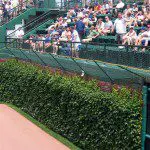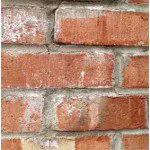16 Aug 2012
Ivy on Brick – Is it a Concern?

You should be concerned about ivy on brick if cracks appear, the mortar is crumbling, or brick is loose. Ivy leafs won’t cause damage but the roots growing in these vulnerable areas of the wall can expand cracks allowing water to penetrate the surface. I know one incident where the ivy opened a caulked crack in a foundation and water seeped in. Homes built before 1930 may be susceptible to damage because of the softer lime-based mortar used then. Mortar replacement or what’s called repointing, may be required.
Tuckpointing ivy covered brick requires removing or carefully pulling the ivy loose to apply a coating of cement-based mortar over existing joints. The ivy can then be repositioned or replanted. The ivy at Wrigley Field is Boston Ivy and Japanese Bittersweet. Bill Veeck planted it in 1937 during an outfield beautification project.
For your own beautification project keep the brick and mortar in good shape. The ivy won’t infiltrate a well-built, solid brick wall. If you have questions about tuckpointing your ivy covered brick walls in the Chicago metro area give me a call.
Bricks naturally contain water-soluble salts. When moisture penetrates the brick, salts make their way to the surface and when the water evaporates, a white powdery substance containing salt is left behind. Water from behind or underneath the brick, poor caulking, bad flashing or underground water migrating up can cause efflorescence.
How to Remove Efflorescence
Removal of the white powder depends on what phase the “flowering” is in. In its earliest phase it can be removed with water and a bristle brush. After it has become insoluble, a mild acid solution can work. The Masonry Institute of America has seen good results using muriatic acid in a mild solution. Rather than one big dose, several mild applications are recommended. Thoroughly rinsing the area with clean water is very important. Other commercial products are available but must be applied properly to get good results.
Note that cleaning efflorescence will not end the problem. It will reappear unless the natural process of efflorescence is stopped.
How to Protect Against Efflorescence
To protect against efflorescence, people often try using a sealer that repels water and penetrates deep into the brick. However, in Chicago, sealers may actually lead to damage from the freezing and thawing cycles. Vapor barriers, sealers and coatings should be assessed for your conditions. Instead, reduce excessive moisture exposure with copings and flashings. Keep garden hoses and sprinklers away from the brick.
Brick discoloration from efflorescence is a cosmetic problem caused by a natural process. However, excess moisture that causes efflorescence can also cause more serious brick problems over time. Add brick maintenance to your spring cleaning list to keep your brick looking beautiful. Pay attention to water issues that could turn into more serious brick problems.



